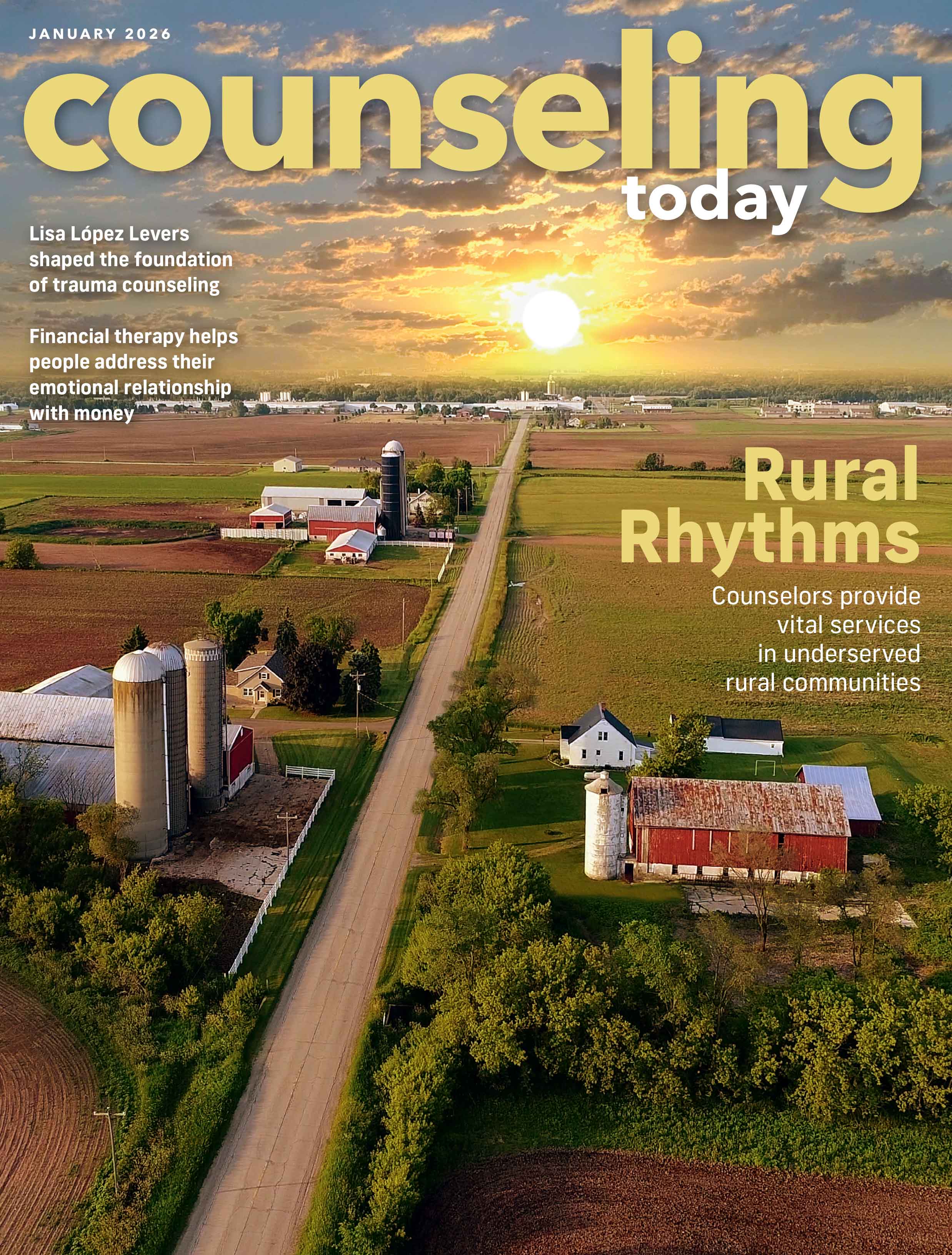Identifying and Supporting Survivors of Human Trafficking
By Lourdes Araujo, EdD, LMHC
May 2025

Human trafficking is pervasive and often clouded by misconceptions that hinder effective intervention. People often believe trafficking only involves physical force, occurs only in least developed countries or exclusively concerns sex trafficking. In reality, victims are often coerced through psychological manipulation and can be found across industries from agriculture to domestic labor. For counselors, recognizing the warning signs of trafficking and offering trauma-informed care are crucial to helping people escape exploitation and begin healing.
Myths and Misconceptions
Public misconceptions about human trafficking can hinder efforts to identify and assist victims. Common myths include the belief that trafficking always involves physical confinement or that victims are always actively seeking help. In reality, traffickers often use psychological coercion, and victims may not recognize their exploitation or may fear authorities, which creates long-lasting negative behavior among victims.
Another prevalent myth is that human trafficking occurs only in least developed countries. According to Refugees International, human trafficking occurs worldwide, including in developed countries, and is not limited to any region or economic status. Many people also believe human trafficking always involves physical force or kidnapping. However, many victims are manipulated or coerced through psychological means or are defrauded, such as through false job promises, fake marriages or threats of deportation.
Another misconception is that human trafficking only involves sex trafficking. The U.S. Department of Homeland Security notes forced labor is another significant form of human trafficking. Such exploitation occurs in industries such as agriculture, restaurants, massage and nail spas, and domestic service.
Recognizing Human Trafficking
Identifying victims of human trafficking can be challenging due to the covert nature of the crime and traffickers’ manipulation tactics, but a victim’s demeanor can provide crucial clues. Many trafficked individuals exhibit extreme fear, anxiety or submissiveness. They may avoid eye contact, seem hypervigilant, struggle to provide consistent details, be confused about their age or display memory loss due to post-traumatic stress disorder (PTSD).
These behavioral indicators, while not definitive proof of trafficking, should prompt further assessment. By recognizing warning signs, counselors can intervene early to help victims escape their situations and begin healing.
Preparing to Work with Survivors
Effective intervention requires awareness, trauma-informed care and collaboration with community resources. Here are some ways counselors can intervene:
Recognize the Signs
Victims of human trafficking often present with physical, psychological and behavioral indicators. Counselors should be aware of signs such as:
- Unexplained physical injuries (burns, cuts, bruises) in various stages of healing
- Malnutrition, dehydration or signs of neglect
- Fearful, anxious or withdrawn behavior, often accompanied by hypervigilance
- Evidence of emotional or psychological abuse, such as extreme submission or avoiding eye contact
- Inconsistent stories or reluctance to speak openly about their living situation
- Restricted movement and lack of personal identification
Establish a Trauma-Informed Approach
Survivors frequently experience complex trauma, including PTSD, depression, anxiety and substance use. To provide effective care, counselors should:
- Create a safe, nonjudgmental space where survivors feel in control of their recovery.
- Practice active listening and vali-date the survivor’s emotions and experiences.
- Be mindful of personal boundaries, cultural sensitivity and potential trauma triggers during sessions.
Understanding and respecting culture and language are crucial when working with victims. Doing so helps establish trust, ensures effective communication and allows for personalized, empathetic support that is sensitive to a person’s unique experience. In a clinical setting, this might involve adapting traditional therapy methods to focus on empowerment rather than pressure. For instance, rather than asking a survivor to recount traumatic experiences immediately, a counselor might first lead grounding exercises to help the person regain a sense of stability and control.
Respond to Immediate Needs
Beyond emotional support, trafficking survivors often require urgent assistance with safety, medical care and legal aid. Counselors should be prepared to:
- Offer psychological first aid and crisis intervention.
- Connect survivors with safe housing or emergency shelters.
- Refer survivors to medical professionals, legal advocates or social services for comprehensive care.
Build a Referral Network
Counselors cannot address all aspects of trafficking recovery alone. Establishing connections with community partners, law enforcement and shelters is essential, along with organizing resources such as checklists, contact lists, press releases and volunteers. Here are some potential community partners:
- Shelters and safe houses specializing in trafficking recovery (local, statewide and national)
- Legal aid organizations that assist survivors with visas, restraining orders or court advocacy (county courthouse)
- Support groups that provide peer connection and empowerment (rape centers, shelters)
- Financial assistance programs that help survivors regain independence
Collaborating with Medical Professionals
Medical professionals are often the first point of contact for trafficking victims because many seek medical care for injuries, infections or untreated chronic conditions. According to the Polaris Project, over 60% of trafficking survivors interact with health care providers before law enforcement or social services get involved.
For example, a trafficking survivor may visit an emergency room with signs of malnutrition, repeated fractures or untreated sexually transmitted infections. If a health care provider notices these signs and asks the right questions in a safe, supportive setting, they can help connect the survivor to appropriate resources. Counselors should build relationships with local health care providers to ensure a coordinated approach that prioritizes the survivor’s needs and safety.
By combining awareness, trauma-informed care, immediate support and collaboration across different professionals, counselors can play a transformative role in helping survivors reclaim their lives.


